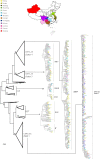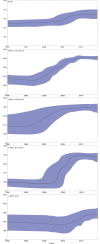Trends of HIV subtypes and phylogenetic dynamics among young men who have sex with men in China, 2009-2014
- PMID: 26577039
- PMCID: PMC4649359
- DOI: 10.1038/srep16708
Trends of HIV subtypes and phylogenetic dynamics among young men who have sex with men in China, 2009-2014
Abstract
To investigate the origins of HIV transmission and phylogenetic dynamics among men who have sex with men (MSM), a total of 1205 newly diagnosed HIV-infected 16-25 year-olds were recruited in 13 provinces across China between 2009 and 2014. Based on phylogenetic analyses of partial pol sequences, HIV-1 subtypes including CRF01_AE (45.3%), CRF07_BC (37.8%), subtype B (6.1%), and B' (3.7%), as well as some other recombinants (7.1%) were identified. In addition to two distinct CRF01_AE clusters [cluster 4 (33.7%, 406/1205) and cluster 5 (7.1%, 85/1205)], we identified a new CRF07_BC cluster (cluster 1) (36.0%, 434/1205), which entered Chinese MSMs in 2004, and had been rapidly spreading since about 2004, which indicating the third wave of the HIV epidemic among the population. Moreover, two new clusters of CRF_01B recombinants were found in this study. The complexities of HIV subtypes and recombinants strongly supports the necessity for a comprehensive study about risk behaviors and their relationship with increasing HIV epidemic subtypes among the MSM group. Implementation and evaluation of comprehensive harm reduction strategies in Chinese MSM are urgently needed.
Figures


Similar articles
-
The prevalence, temporal trends, and geographical distribution of HIV-1 subtypes among men who have sex with men in China: A systematic review and meta-analysis.Epidemiol Infect. 2019 Jan;147:e83. doi: 10.1017/S0950268818003400. Epidemiol Infect. 2019. PMID: 30869019 Free PMC article.
-
Surging HIV-1 CRF07_BC epidemic among recently infected men who have sex with men in Fujian, China.J Med Virol. 2018 Jul;90(7):1210-1221. doi: 10.1002/jmv.25072. Epub 2018 Mar 31. J Med Virol. 2018. PMID: 29574774
-
Phylogenetic and temporal dynamics of human immunodeficiency virus type 1 CRF01_AE and CRF07_BC among recently infected antiretroviral therapy-naïve men who have sex with men in Jiangsu province, China, 2012 to 2015: A molecular epidemiology-based study.Medicine (Baltimore). 2018 Feb;97(6):e9826. doi: 10.1097/MD.0000000000009826. Medicine (Baltimore). 2018. PMID: 29419684 Free PMC article.
-
Increase of RT-related transmitted drug resistance in non-CRF01_AE among HIV type 1-infected men who have sex with men in the 7 cities of China.J Acquir Immune Defic Syndr. 2015 Mar 1;68(3):250-5. doi: 10.1097/QAI.0000000000000467. J Acquir Immune Defic Syndr. 2015. PMID: 25469530
-
Overview of HIV molecular epidemiology among people who inject drugs in Europe and Asia.Infect Genet Evol. 2016 Dec;46:256-268. doi: 10.1016/j.meegid.2016.06.017. Epub 2016 Jun 7. Infect Genet Evol. 2016. PMID: 27287560 Free PMC article. Review.
Cited by
-
HIV-1 CRF07_BC transmission dynamics in China: two decades of national molecular surveillance.Emerg Microbes Infect. 2021 Dec;10(1):1919-1930. doi: 10.1080/22221751.2021.1978822. Emerg Microbes Infect. 2021. PMID: 34498547 Free PMC article.
-
The prevalence of CRF55_01B among HIV-1 strain and its connection with traffic development in China.Emerg Microbes Infect. 2021 Dec;10(1):256-265. doi: 10.1080/22221751.2021.1884004. Emerg Microbes Infect. 2021. PMID: 33512306 Free PMC article.
-
Spatiotemporal Patterns of CRF07_BC in China: A Population-Based Study of the HIV Strain With the Highest Infection Rates.Front Immunol. 2022 Feb 14;13:824178. doi: 10.3389/fimmu.2022.824178. eCollection 2022. Front Immunol. 2022. PMID: 35237270 Free PMC article.
-
The prevalence, temporal trends, and geographical distribution of HIV-1 subtypes among men who have sex with men in China: A systematic review and meta-analysis.Epidemiol Infect. 2019 Jan;147:e83. doi: 10.1017/S0950268818003400. Epidemiol Infect. 2019. PMID: 30869019 Free PMC article.
-
Transmitted drug resistance and transmission clusters among ART-naïve HIV-1-infected individuals from 2019 to 2021 in Nanjing, China.Front Public Health. 2023 Aug 22;11:1179568. doi: 10.3389/fpubh.2023.1179568. eCollection 2023. Front Public Health. 2023. PMID: 37674678 Free PMC article.
References
-
- Ma Y., Li Z. Z. & Zhao S. D. HIV was first discovered among IDUs in China. Chinese Journal of Epidemiology 11, 184–185 (1990).
-
- State council AIDS working committee office & UN theme group on AIDS in China. A joint assessment of HIV/AIDS prevention, treatment and care in China (2007). Available at: http://www.chinaaids.cn/ddpg/lhpgbg1/zgazbyq/201312/t20131220_91605.htm. (Accessed: 16th April 2015).
-
- Centers for Disease, C. Pneumocystis pneumonia–Los Angeles. MMWR 30, 250–252 (1981). - PubMed
Publication types
MeSH terms
LinkOut - more resources
Full Text Sources
Other Literature Sources
Medical
Molecular Biology Databases

